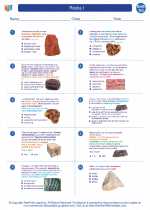Topaz
Topaz is a silicate mineral that can be found in a variety of colors, including yellow, orange, brown, pink, and blue. It is a popular gemstone and is also used in industrial applications.
Physical Properties
- Color: Topaz comes in a wide range of colors, with the most common being yellow and brown.
- Hardness: It has a hardness of 8 on the Mohs scale, making it a durable gemstone suitable for jewelry.
- Crystal Structure: Topaz crystals are often prismatic and can have well-defined striations on the sides.
- Cleavage: Topaz has perfect basal cleavage, meaning it can be cleaved into flat, reflective surfaces.
Formation and Occurrence
Topaz is typically formed in igneous rocks such as granite and pegmatite, as well as in high-temperature hydrothermal veins. It is often found in association with minerals such as quartz, fluorite, and tourmaline.
Uses
- Gemstone: Topaz is commonly used as a gemstone in jewelry, with the blue and pink varieties being particularly prized.
- Industrial Applications: Due to its hardness and clarity, topaz is also used in industrial applications such as optical instruments and abrasives.
Study Guide
When studying topaz, it's important to focus on its physical properties, formation, occurrence, and uses. Additionally, be familiar with the different colors in which topaz can occur and the significance of those colors in the gemstone market. Understanding the crystal structure and cleavage of topaz is also essential for a comprehensive knowledge of the mineral.
Consider exploring the geological environments where topaz is commonly found and the processes that lead to its formation. Lastly, be aware of the industrial applications of topaz and how its properties make it suitable for various uses beyond jewelry.
Overall, a well-rounded understanding of topaz involves a combination of mineralogical, geological, and commercial aspects, making it a fascinating subject of study for Earth science enthusiasts.
.◂Earth Science Worksheets and Study Guides High School. Rocks I

 Worksheet/Answer key
Worksheet/Answer key
 Worksheet/Answer key
Worksheet/Answer key
 Vocabulary/Answer key
Vocabulary/Answer key
 Vocabulary/Answer key
Vocabulary/Answer key
 Vocabulary/Answer key
Vocabulary/Answer key
